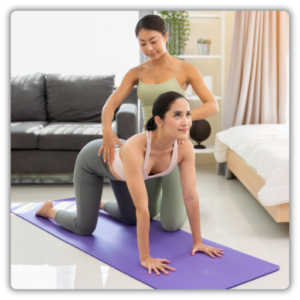Introduction
Good posture is essential for overall health and well-being. It influences not only how you look but also how you feel and function in your daily life. Poor posture can lead to various posture problems, including back pain, stiffness, and even long-term spinal issues.
Harvard Health Publishing even says that “back pain and can affect the position and function of your abdominal organs, inhibit breathing and oxygen intake, and cause headaches. It may also affect mood.” In this article, we will explore seven effective exercises to improve your posture with valuable insights from chiropractors.KEY POINTS
- Good posture is essential for overall health, as it helps maintain spinal alignment, reduces muscle strain, and can improve breathing and digestion while preventing conditions like arthritis and chronic pain.
- Chiropractors play a crucial role in addressing posture issues through spinal adjustments and personalized exercise recommendations, promoting better alignment and overall musculoskeletal health.
- Targeted exercises, such as the Wall Angel and Plank, are effective for strengthening core and upper body muscles while enhancing flexibility, contributing to improved posture.
- Making ergonomic adjustments in your workspace and practicing mindfulness can help maintain good posture throughout the day, reducing the risk of posture-related problems and discomfort.
Why is Good Posture Important?
 Good posture is important because it helps maintain the natural curves of the spine, reducing the strain on muscles and ligaments. When you have proper posture, you are less likely to experience discomfort in the back and neck. Additionally, maintaining good posture can improve your breathing, promote better digestion, and enhance your overall physical performance, which is often emphasized by physical therapists. On the contrary, bad posture can lead to conditions such as arthritis, forward head posture, and chronic pain, which can also cause lower back pain, making it vital to work on posture improvement regularly.
Good posture is important because it helps maintain the natural curves of the spine, reducing the strain on muscles and ligaments. When you have proper posture, you are less likely to experience discomfort in the back and neck. Additionally, maintaining good posture can improve your breathing, promote better digestion, and enhance your overall physical performance, which is often emphasized by physical therapists. On the contrary, bad posture can lead to conditions such as arthritis, forward head posture, and chronic pain, which can also cause lower back pain, making it vital to work on posture improvement regularly.
How Can a Chiropractor Help with Posture?
A chiropractor may assist in addressing posture issues by performing spinal adjustments and offering personalized exercise recommendations. They can help correct spinal misalignments that contribute to poor posture and provide manual therapy to relieve tightness in the upper back and lower back. Furthermore, chiropractors often educate patients about the importance of maintaining proper posture and suggest effective exercises to improve posture. By integrating chiropractic care with exercise, individuals can achieve better posture and overall health.
What Will You Learn from This Article?
This article will introduce you to the significance of good posture and how it can impact your health. You will learn about the common causes of poor posture and the types of exercises that are most beneficial for improving posture. Additionally, we will outline seven specific exercises recommended by chiropractors to enhance your posture effectively. Finally, we will provide tips for maintaining good posture in your daily life, ensuring that you have the tools you need for long-term posture improvement, as advised by physiotherapy experts.

Pop in your email below, and we’ll zip it straight to your inbox so you never lose it!
Understanding Posture: What Is It and Why Does It Matter?
What Is Posture?
Posture refers to the position of the body in relation to the surrounding environment, including how you hold your spine, head, and limbs. Good posture is characterized by the alignment of the spine and the position of the pelvis, ensuring that the body’s weight is evenly distributed. Conversely, poor posture can manifest in various forms, such as slouching, rounded shoulders, and a forward head position. Understanding posture is crucial, as it plays a significant role in your physical health and overall well-being.
How Does Poor Posture Affect Your Health?
 Poor posture can have a detrimental impact on your health, leading to various physical ailments. It can contribute to back pain, neck pain, and stiffness in the upper back and lower back, affecting your ability to perform daily tasks. Over time, poor posture can also lead to structural changes in the spine, resulting in chronic conditions such as arthritis or herniated discs. Moreover, it can restrict lung capacity and hinder circulation, which may negatively affect your energy levels and overall vitality. By addressing posture problems through targeted exercises, you can significantly enhance your health.
Poor posture can have a detrimental impact on your health, leading to various physical ailments. It can contribute to back pain, neck pain, and stiffness in the upper back and lower back, affecting your ability to perform daily tasks. Over time, poor posture can also lead to structural changes in the spine, resulting in chronic conditions such as arthritis or herniated discs. Moreover, it can restrict lung capacity and hinder circulation, which may negatively affect your energy levels and overall vitality. By addressing posture problems through targeted exercises, you can significantly enhance your health.
What Are the Common Causes of Poor Posture?
Several factors can lead to poor posture, including sedentary lifestyles, repetitive movements, and ergonomic deficiencies in your workspace. Spending long hours sitting at a desk can encourage slouching and forward head posture. Other causes may include muscle imbalances, tightness in the chest and shoulders, and weakness in the core muscles. Additionally, stress and fatigue can contribute to postural issues, as individuals may subconsciously lean or hunch when feeling overwhelmed. Identifying these causes is essential for developing an effective plan to improve your posture.

Pop in your email below, and we’ll zip it straight to your inbox—plus, you’ll be first in line for all our fresh, new articles!
How Can Exercises Improve Your Posture?
What Types of Exercises Are Best for Posture Improvement?
 Exercises to improve your posture typically focus on strengthening the core and upper body while enhancing flexibility. Resistance training, such as weightlifting or bodyweight exercises, can help build the necessary muscle strength to support proper spinal alignment. Additionally, incorporating stretching routines can alleviate tightness, particularly in the chest and shoulders. Pilates and yoga are excellent options for improving posture, as they promote body awareness and teach proper alignment through various poses and movements. By consistently practicing these exercises, you can effectively enhance your posture.
Exercises to improve your posture typically focus on strengthening the core and upper body while enhancing flexibility. Resistance training, such as weightlifting or bodyweight exercises, can help build the necessary muscle strength to support proper spinal alignment. Additionally, incorporating stretching routines can alleviate tightness, particularly in the chest and shoulders. Pilates and yoga are excellent options for improving posture, as they promote body awareness and teach proper alignment through various poses and movements. By consistently practicing these exercises, you can effectively enhance your posture.
Why Is Strengthening Core Muscles Essential?
Strengthening core muscles is essential for good posture because the core serves as the foundation for stability and balance. The core includes not just the abdominal muscles but also the back muscles, pelvic floor, and diaphragm. A strong core helps support the spine, preventing slouching and maintaining proper alignment. Weak core muscles can lead to an increased risk of poor posture, resulting in discomfort and potential injury. By engaging in core-strengthening exercises, such as planks and bridges, you can develop a stable base that promotes better posture.
How Can Flexibility Exercises Help Your Posture?
Flexibility exercises play a critical role in improving posture by alleviating tightness in the muscles that can pull the body out of alignment. When certain muscle groups, such as the chest and hip flexors, become tight, they can contribute to rounded shoulders and an anterior pelvic tilt. Stretching these muscles through targeted flexibility exercises can help restore balance and allow the body to return to a more neutral position. Incorporating flexibility training, such as yoga or dedicated stretching routines, can significantly enhance your posture and overall mobility.
7 Effective Exercises to Enhance Your Posture
1. What Is the Wall Angel Exercise?
2. How to Perform the Plank for Better Core Strength?
The plank is a fundamental exercise that helps strengthen the core, which is vital for maintaining proper posture. To perform a plank, start in a push-up position with your arms straight and your body in a straight line from head to heels. Engage your core, ensuring that your hips do not sag or rise. Hold this position for 30 seconds to one minute, focusing on breathing steadily, which is essential for maintaining correct posture. Incorporating variations of the plank, such as side planks or forearm planks, can further enhance core strength, supporting better posture over time.
3. Why Are Shoulder Blade Squeezes Important?
Shoulder blade squeezes are crucial for improving posture, particularly for counteracting rounded shoulders. To perform this exercise, sit or stand up straight and pull your shoulder blades together, as if you are trying to pinch a pencil between them. Hold the squeeze for a few seconds before releasing and repeating the movement. This exercise strengthens the muscles in the upper back, promoting better posture and reducing the tendency to hunch forward. Regular practice can help correct shoulder positioning and alleviate associated discomfort.
4. How Does the Cat-Cow Stretch Improve Flexibility?
The Cat-Cow stretch is a dynamic movement that enhances flexibility in the spine, helping to improve posture. To perform this stretch, start on your hands and knees in a tabletop position. Inhale as you arch your back, allowing your belly to lower and your head to lift (Cow position), which can help improve posture. Exhale as you round your spine, tucking your chin to your chest and pulling your belly button toward your spine (Cat position), which helps improve posture. This gentle flow helps increase spinal mobility, alleviating tightness that can lead to poor posture.
5. What Is the Importance of the Chest Opener Stretch?
The Chest Opener stretch is vital for counteracting tightness in the chest, which is a common contributor to poor posture. To perform this stretch, stand or sit with your back straight. Clasp your hands behind your back and gently pull your shoulders back and down, opening up the chest. Hold the stretch for 15-30 seconds, breathing deeply, as this can help improve posture and flexibility. This movement helps to elongate the chest muscles and promotes better shoulder alignment, ultimately aiding in the correction of rounded shoulders and forward head posture, which many seek to correct through physiotherapy.
6. How to Do the Bird-Dog Exercise for Balance?
The Bird-Dog exercise is an excellent way to enhance balance and strengthen the core and back muscles. To perform it, start on your hands and knees in a tabletop position. Extend your right arm forward and your left leg backward simultaneously, keeping your body stable. Hold for a few seconds, then return to the starting position and switch sides. This exercise engages multiple muscle groups, encouraging spinal stability and supporting overall posture improvement. Regular practice can lead to better coordination and body awareness.
7. What Role Does the Bridge Exercise Play in Posture?
The Bridge exercise is effective for strengthening the glutes and lower back, both of which are crucial for maintaining proper posture. To perform this exercise, lie on your back with your knees bent and feet flat on the floor. Press through your heels to lift your hips toward the ceiling, squeezing your glutes at the top. Hold for a moment before lowering back to the ground. This exercise helps develop strength in the posterior chain, promoting an aligned pelvis and reducing the risk of developing poor posture.
Integrating Chiropractic Care with Your Exercise Routine
What Techniques Do Chiropractors Use to Improve Posture?
 Chiropractors utilize various techniques to improve posture, focusing on spinal alignment and overall musculoskeletal health, and can help improve posture significantly. They may perform spinal adjustments to correct misalignments that lead to poor posture and offer manual therapy to relieve muscle tightness. Additionally, chiropractors often provide guidance on posture exercises tailored to individual needs, helping patients incorporate these exercises into their daily routines. This holistic approach, often utilized by physical therapists, allows individuals to address posture problems effectively and achieve better posture over time.
Chiropractors utilize various techniques to improve posture, focusing on spinal alignment and overall musculoskeletal health, and can help improve posture significantly. They may perform spinal adjustments to correct misalignments that lead to poor posture and offer manual therapy to relieve muscle tightness. Additionally, chiropractors often provide guidance on posture exercises tailored to individual needs, helping patients incorporate these exercises into their daily routines. This holistic approach, often utilized by physical therapists, allows individuals to address posture problems effectively and achieve better posture over time.
How Often Should You Visit a Chiropractor for Posture Improvement?
The frequency of chiropractic visits for posture improvement can vary based on individual needs and the severity of posture issues. Generally, it’s a good idea to consult with a chiropractor to determine a customized treatment plan. Many individuals may benefit from visiting a chiropractor two to four times a month, especially during the initial stages of treatment. As posture improves, visits may become less frequent. Regular check-ups can help maintain progress and prevent the recurrence of posture problems, ensuring long-term health benefits.
Tips for Maintaining Good Posture in Daily Life
What Ergonomic Adjustments Can You Make at Work?
 Ergonomic adjustments at work can significantly improve posture and reduce the risk of developing posture problems. Ensure your chair supports your lower back, and keep your feet flat on the floor while your knees are at a 90-degree angle. Position your computer screen at eye level to avoid leaning forward, and use a headset for phone calls to maintain a neutral neck position, which is crucial for correct posture. Regularly take breaks to stretch and walk around, which can help relieve tightness and stiffness, promoting better posture throughout the workday and reducing the risk of lower back pain.
Ergonomic adjustments at work can significantly improve posture and reduce the risk of developing posture problems. Ensure your chair supports your lower back, and keep your feet flat on the floor while your knees are at a 90-degree angle. Position your computer screen at eye level to avoid leaning forward, and use a headset for phone calls to maintain a neutral neck position, which is crucial for correct posture. Regularly take breaks to stretch and walk around, which can help relieve tightness and stiffness, promoting better posture throughout the workday and reducing the risk of lower back pain.
How Can Mindfulness Help You Stay Aware of Your Posture?
Mindfulness can play a crucial role in helping you stay aware of your posture throughout the day. By practicing mindfulness, you can develop greater body awareness and recognize when you’re slipping into poor posture habits, such as slouching or leaning forward. Incorporating mindfulness techniques, such as deep breathing or meditation, can help you tune in to your body and remain conscious of your posture in various situations. This heightened awareness can lead to more intentional movements and ultimately contribute to long-term posture improvement.
What Daily Habits Can Help Support Good Posture?
Incorporating daily habits that support good posture can make a significant difference in your overall alignment, as advised by physiotherapy professionals. Make it a habit to sit up straight, keeping your shoulders relaxed and your back supported. When standing, distribute your weight evenly on both legs and avoid locking your knees. Engage in regular physical activity that includes exercises and stretches targeting posture improvement. Additionally, consider using reminders, such as sticky notes or phone alarms, to prompt you to check your posture throughout the day, reinforcing good habits over time.











